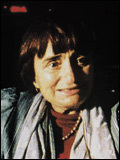
Filmmakers |
 |
 AGNÈS VARDA
AGNÈS VARDA Varda’s beginnings were promising: La Pointe Courte won the Grand Prize of the Avant-Garde Film in Paris in 1955 and, the same year, the Golden Age Prize in Brussels. Retrospectively, in the light of the first feature films of the young cineastes of the New Wave — Truffaut, Godard, Chabrol, and Resnais, among others — Varda would come to be perceived as one of the forerunners of that current or, as some liked to say, as the “grandmother of the New Wave.” Before completely abandoning her career as a photographer in 1960, Varda made three short documentaries. These included two commissioned films, O saisons, ô châteaux (1957), on the Loire Valley castles, and On the Coast (Du côté de la côte, 1958), about the tourists of the French Riviera. The third was L’Opéra-mouffe (1958), in which we see, through the eyes of a pregnant woman, the people who frequent the open air market on the rue Mouffetard in Paris. Although Varda was no longer a professional photographer, she would never abandon photography completely. Her films, which are always striking by their formal beauty, often include photos and static images of all kinds which enrich their thematic register. Salut les Cubains, on Castro’s Cuba (see below), is composed entirely of a montage of 1500 photographs.
During the following twenty-five years, before making Vagabond, Varda directed seven feature films, including four fiction films: Cléo de 5 à 7 (1961), Happiness (Le Bonheur, 1964), Les Créatures (1965), and One Sings, the Other Doesn’t (L’une chante, l’autre pas, 1976). Her second feature film Cléo from 5 to 7 identifies her clearly with the New Wave — at least its politicized, literary, and esthetically oriented branch known as the “Left Bank” group, which also included Alain Resnais and Chris Marker. In this film Varda shot in real time (from five o’clock to six-thirty) a critical moment in the life of a little Parisian pop singer who awaits anxiously the results of tests which will determine if she has cancer or not. The film was selected for both the Cannes and Venice Film Festivals in 1962 before receiving the Méliès Prize the same year. Happiness is a reflection on the nature of happiness, as well as on the right to happiness through love outside of conventional morality. A “scandalous” film, Happiness nonetheless won the Louis Delluc Prize in 1965 and the Golden Bear at the Berlin Film Festival the same year. The following film, The Creatures, which establishes a parallel between the life of a couple and the genesis of a novel, was characterized as a “cold and cerebral work” (Ford, 114). It was generally panned by both the critics and the public, despite its selection for the Venice Film Festival in 1966. One Sings, the Other Doesn’t, which is devoted to questions concerning the right of women to decide to have children or not (contraception and abortion), relates the personal battle of two young women. It is clearly meant to be a homage to the feminist movement in France, which Varda supported unreservedly. Her film won the Grand Prize at the Taormina Film Festival in Italy in 1977.
In 1969 in Los Angeles Varda shot Lions Love and Lies, which is half documentary and half fiction. It depicts the hippie scene of avant-garde Hollywood actors, woven into the presidential campaign and the assassination of Robert Kennedy. In this period Varda devoted herself principally to documentaries, making a long series of short subjects, some of which were tied to leftwing politics, such as Salut les Cubains (1963) and Black Panthers (1968). The best known and some of the longest of these films include Daguerréotypes (1974-75), a documentary on the inhabitants of the rue Daguerre in Paris, the street where Varda lives, and Walls Walls (Murs murs, 1980), a reflection on the people of Los Angeles based on mural paintings. Documenteur (1980-81), a mid-length film, is the portrait of a young woman and her son who live in exile in Los Angeles. The film is also about the woman’s relations with other people and with the city itself, focusing on its poorest residents — the beggars, the abandoned, and the drunks. In 1982 Varda won a Cesar at Cannes for Ulysse, a short subject which explores an image from the past, a posed photograph she had taken nearly thirty years before in which we see a naked man standing on a pebble-covered beach and looking at the sea, a naked child sitting on the beach, and a dead goat.
After Vagabond (1985), Varda made a documentary on the actress Jane Birkin (1987), Jane B. by Agnès V., followed the same year by a fiction film, Kung-Fu Master, which stars Birkin. In the early nineties she devoted several documentaries to her recently deceased husband, the filmmaker Jacques Demy, including Jacquot de Nantes in 1991. At the very end of the century, Varda once again triumphed with a feature-length documentary film, The Gleaners and I (2000)—made in digital video—which treats of human scavengers who live off the leavings of others, including “gleaners” of images like filmmakers.
At the beginning of the new century, as she continued to make films, Varda received two awards for her life’s work in film, including an honorary Ceasar in 2001.